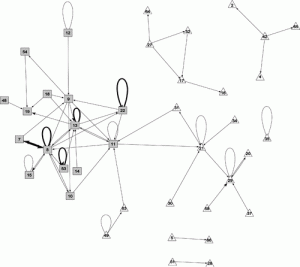Murder Networks: Using Social Networks to Combat Gang Violence
In 2009, the American Journal of Sociology published an article by Andrew V. Papachristos, a professor at the University of Massachusetts, Amherst who spent over a year of his life shadowing and interviewing members of several street gangs on Chicago’s West and South sides in order to understand the dynamics within gangs, interactions between rival gangs and the exchange of violence between individuals and groups. He used the information he collected in addition to data provided to him by the Chicago Police Department in order to construct a “murder network” detailing every murder committed by every gang or gang member in the city for each year from 1998-2002. He found that the patterns in the structure of each of these networks were similar from year to year. His conclusion was that contrary to popular theory, which alleges that gang homicides tend to be chaotic and random, murders between gangs tend to follow a pattern which is institutionalized and which persists with time and determines future interactions and behavior. The articles also points out that this is rather remarkable, since gang membership tends to be transient and ordinarily spans a few years. However, the gang structure remains stable despite the high turnover of members and leadership.

Gang Social Structure 2002
Fig. 4.— The social structure of gang homicide in Chicago, 2002. Squares represent black gangs; triangles represent Hispanic gangs; diamonds represent Asian gangs; circles represent white gangs; direction of arrow indicates direction of homicides; and thickness of line indicates number of homicides between gangs.
Papachristos also characterized homicides and other acts of violence between gangs as attempts to express dominance over other groups. In turn, the victimized group is forced to retaliate in order to regain their status and not to appear weak to rival gangs. This carries out the combined function of re-asserting their power and preventing further victimization of the gang. This creates a back-and-forth escalation of violence between groups, creating stronger links, which can also be analyzed and used to predict future patterns of violence. The article states that “while an individual member pulls the trigger, it is the structure that determines who kills whom.” These graphs also reveal the power dynamics among gangs. Gangs connected to the largest number of edges (which in this case represents both their committed murders and number of victims) are the largest and most powerful.
This application of social networks is a powerful one because it provides insight into more effective ways that the city might go about trying to combat gang violence, something it has been relatively unsuccessful at in the last decade in comparison to other large cities in the US. By disrupting such networks, targeting particular gangs through direct intervention, and essentially eliminating as many edges as possible, the entire system could be destabilized. Targeting the organizational structure of the most powerful gangs and minimizing the amount of power held by any single gang would potentially be a good strategy for shrinking and eventually destroying the broader “murder network” altogether.
Link: http://www.jstor.org/stable/10.1086/597791
